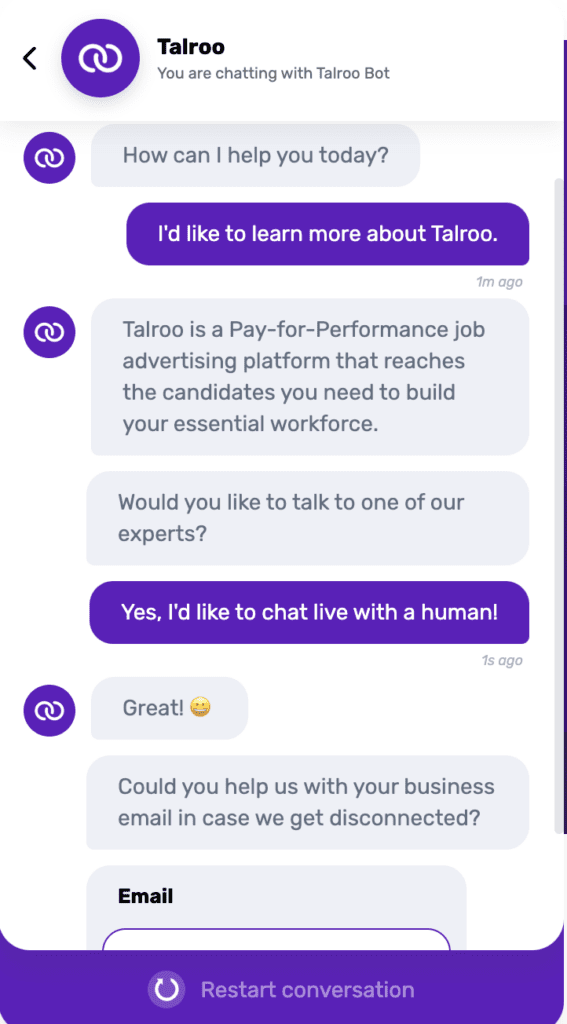
Qualified talent is hard to find, and it’s not getting any easier. Economic shifts, a widening skills gap, and the need for key roles across enterprises has made recruiting highly competitive! This challenge has led to burnt out recruiters and high HR turnover across the board. Even though demand has surged, 57% of HR professionals say their recruiting team has shrunk over the past year. Recruiters are working harder and TA leaders are looking for ways to support their recruitment efforts with smaller teams.
The landscape of HR technology has changed significantly in the past two years. Needing automation for virtual workforces, recruiting teams are seeking out ways to help remote workers operate efficiently. Recruiters are using artificial intelligence to source, screen, schedule and chat which has made it a not just a luxury, but a necessity.
Related: How Automation Increases Your Candidate Experience
AI-based recruiting technology has rapidly evolved to help TA teams reach a larger, more targeted candidate audience. It improves the candidate experience by increasing the speed in which candidates are sourced and screened, ultimately improving time-to-hire.
What AI is for Recruitment and Talent Acquisition
At a basic level, artificial intelligence is about developing computer systems and algorithms to perform tasks associated with human-like perception. We tend to think about automated processes as impersonal and robotic. However, AI can actually personalize and humanize many of the touch-points we perform manually.
In the recruiting life cycle, automation has advanced to the point of streamlining just about every facet of recruiting, screening and selection. Remember, this technology focuses on “human-like” automation. Here, we’ll cover five of the most common ways in which AI technology supports recruiting teams.
Chatbots.
They’ve been around for years, but the technology has drastically improved! The canned responses of yesteryear have since evolved into customized conversations that do far more than answer sets of FAQs. Plus, they are easier than ever to implement.
Want to see what a chatbot experience is like? Spend a few minutes on Talroo.com and meet “Jessica,” Talroo’s AI chat assistant. If she doesn’t know the answer, she’ll put you in touch with someone who does — quickly and easily.

Reach.
By using data, intelligent algorithms allow advertisers to exponentially improve their campaigns’ effectiveness, particularly in areas of targeted reach. Intelligent algorithms are constantly learning, which means — the more you use them, the better they work! Programmatic AI is built on this concept, and is what Talroo does extremely well. For example, once your posting is ready, your targeted reach is projected based on audience size and geographic data. In real time, automation assesses the efficacy of your campaign, recommends adjustments to improve reach, and optimizes campaign performance. That means more mileage out of every dollar in your advertising budget!
Job ads.
With interview-driven job ads, Talroo leverages conversational AI that puts the right job in front of the right job seeker. In an interview with AIthority, Talroo CEO Thad Price explains:
“By contextualizing job ads with key incentives, enhancing company profiles, and utilizing calls to action that are optimized for scheduling interviews — Talroo is improving the candidate experience and helping increase applicant conversions by closing the gap between the job ad and the interview. With more recruiters using tools like chatbots to increase applicant conversions and decrease the time-to-hire, our interview-driven profile enhancements are helping to guide higher-quality candidates to the application stage.”
Matching.
Automation technology allows companies like Talroo to program job-matching algorithms. Then, they scan resumes for keywords and operate within the parameters you identified for the role. This technology narrows hundreds of resumes down to dozens of qualified candidates. Thus, the promise of its AI lies in the ability to leverage data, matching candidates’ experience and skills to your job requirements.
Related: 7 Ways to Streamline Healthcare Recruiting with Automation
Qualifying.
After the initial automatic screening, AI adapts the job qualification process to a list of auto-generated questions, saving recruiters valuable time. Does it affect your candidates’ experiences? Of course, but only positively! Your recipients don’t know (or care) if the questions are auto-generated or sent by a human being. Instead, that recruiter now has the time to personalize messages for candidates further down the hiring funnel!
There are more benefits to using AI in recruiting — from data aggregation to consolidation of analytics — your HR tech stack is able to improve hiring costs while reducing bias in the screening process. What TA leaders are looking for right now are smarter ways to use AI technology to speed time-to-hire and reduce pressure on their overworked recruitment teams. AI won’t solve every challenge, but it certainly reduces time spent on manual tasks and helps your recruiters find qualified candidates quickly and easily without burn out!




